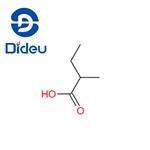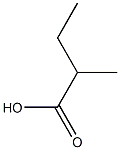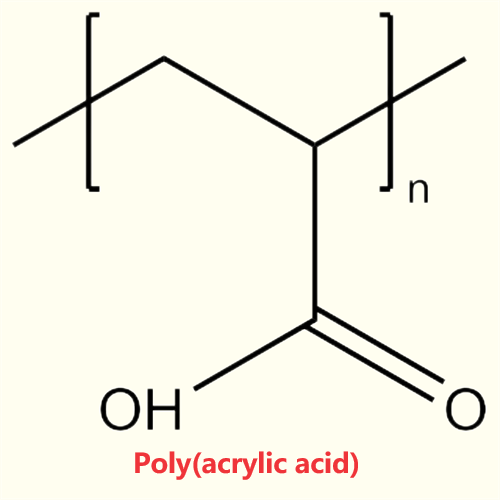What is Poly(acrylic acid)?
General Description
Poly(acrylic acid) or PAA (CAS number 9003-1-04) is a type of polymer. The monomer of poly(acrylic acid) is Acrylic Acid. In a water solution at neutral pH, many of the side chains of PAA will lose their protons and acquire a negative charge.
For a description of unrelated compounds expanded by twocarbon units,Poly acrylic acid (PAA or Carbomer) is generic name for synthetic high molecular weight polymers of acrylic acid. They may be homopolymers of acrylic acid, crosslinked with an allyl ether pentaerythritol, allyl ether of sucrose or allyl ether of propylene. In a water solution at neutral pH, PAA is an anionic polymer, i.e. many of the side chains of PAA will lose their protons and acquire a negative charge.
This makes PAAs polyelectrolytes, with the ability to absorb and retain water and swell to many times their original volume. Dry PAAs are found in the market as white and fluffy powders. Carbomer codes (910, 934, 940, 941 and 934P) are an indication of molecular weight and the specific components of the polymer. For many applications PAAs are used in form of alkali metal or amonium salts e.g. sodium polyacrylate.
Polymethyl acrylate is an acrylic resin used in an emulsed form for lacquer, textile finishes, adhesives and, mixed with clay, to gloss paper. Another acrylic resin is polymethyl methacrylate which is used to make hard plastics with various light transmitting properties.
Properties & Performance
Polyacrylic acid is a large-molecular-weight compound called a polymer, which consists of small repeating units called monomers. The polyacrylate polymer used in diapers is constructed from the acrylic acid and sodium acrylate monomers. The length of the polymer chain and the properties of the polymer may be changed by varying the reaction conditions. The reaction conditions can affect the the length of the chains and can change the characteristics of the polymer. The polyacrylate is dried and formed into microparticles of irregular shape that are stable for extended periods. The particles quickly swell and absorb water, urine, or other aqueous solutions.
Polyacrylic acid is a polyelectrolyte which is soluble in aqueous media at neutral pH, due to the ionization of the pendent carboxyl side chains. Carbopols are polymers of acrylic acid that have been cross-linked with polyalkanyl esters or divinyl glycol. Carbopols readily absorb water, become hydrated and swell: their hydrophilic nature and cross-linked structure make them suitable for controlled drug delivery systems [15,43]. Moreover, these polymers are non-toxic and non-irritating.
Acrylic resin is a general term for any one of the plastics (resin) generated through chemical reaction by applying polymerization initiator and heat to a monomer.
The chemical name for the resin produced from the methyl methacrylate monomer (MMA) is polymethyl methacrylate (PMMA). MMA is a transparent and colorless fluid substance.One of the main characteristic features of PMMA is its high transparency. With its high weather resistance, it has been known to last over 30 years, it does not easily turn yellow or crumble when exposed to sunlight. Polymethyl methacrylate is used not only for transparent windows in aquariums but also for various items such as signboards in places like convenience stores, taillights of automobiles, bathtub liners, sinks, cell phone display screens, backlight optical waveguides for liquid crystal displays (LCD) and so on.
Applications
Dry PAA is a white solid. It is capable of absorbing many times its weight in water, and hence is used in disposable diapers. Indiapers it is a fine powder - see picture of material form a diaper.
Polyacrylic acid is found in a wide variety of household and personal care products:
Diapers
Hand sanitizer
Mascara
Aftershave
Toothpaste
Hair-styling products (gels, dyes, sprays)
Moisturizer
Pet shampoo
Metal polish
Pharmaceutical Applications
Carbomers are used in liquid or semisolid pharmaceutical formulations as rheology modifiers. Formulations include creams, gels, lotions and ointments for use in ophthalmic, rectal, topical and vaginal preparations. Carbomer grades with residual benzene content greater than 2 ppm do not meet the specifications of the PhEur 6.4 monograph. However, carbomer having low residuals of other solvents than the ICH-defined ‘Class I OVI solvents’ may be used in Europe. Carbomer having low residuals of ethyl acetate, such as Carbopol 971P NF or Carbopol 974P NF, may be used in oral preparations, in suspensions, capsules or tablets.
Carbomer polymers have also been investigated in the preparation of sustained-release matrix beads, as enzyme inhibitors of intestinal proteases in peptide-containing dosage forms, as a bioadhesive for a cervical patch and for intranasally administered microspheres, in magnetic granules for site-specific drug delivery to the esophagus, and in oral mucoadhesive controlled drug delivery systems. Carbomers copolymers are also employed as emulsifying agents in the preparation of oil-in-water emulsions for external administration. Carbomer 951 has been investigated as a viscosity-increasing aid in the preparation of multiple emulsion microspheres. Carbomers are also used in cosmetics. Therapeutically, carbomer formulations have proved efficacious in improving symptoms of moderate-to-severe dry eye syndrome.
Production
Carbomers are synthetic, high-molecular-weight, crosslinked polymers of acrylic acid. These acrylic acid polymers are crosslinked with allyl sucrose or allyl pentaerythritol. The polymerization solvent used previously was benzene; however, some of the newer commercially available grades of carbomer are manufactured using either ethyl acetate or a cyclohexane–ethyl acetate cosolvent mixture. The Carbopol ETD and Carbopol Ultrez polymers are produced in the cosolvent mixture with a proprietary polymerization aid.
Safety
Carbomers are used extensively in nonparenteral products, particularly topical liquid and semisolid preparations. Grades polymerized in ethyl acetate may also be used in oral formulations. There is no evidence of systemic absorption of carbomer polymers following oral administration. Acute oral toxicity studies in animals indicate that carbomer 934P has a low oral toxicity, with doses up to 8 g/kg being administered to dogs without fatalities occurring. Carbomers are generally regarded as essentially nontoxic and nonirritant materials; there is no evidence in humans of hypersensitivity reactions to carbomers used topically.
Regulatory Status
Included in the FDA Inactive Ingredients Database (oral suspensions, tablets; ophthalmic, rectal, topical, transdermal preparations; vaginal suppositories). Included in nonparenteral medicines licensed in Europe. Included in the Canadian List of Acceptable Nonmedicinal Ingredients.
Related articles And Qustion
See also
Lastest Price from Poly(acrylic acid) manufacturers

US $0.00/kg2025-11-19
- CAS:
- 9003-01-4
- Min. Order:
- 1kg
- Purity:
- 98%
- Supply Ability:
- 1000kgs

US $3.00-9.00/KG2025-06-19
- CAS:
- 9003-01-4
- Min. Order:
- 0.1KG
- Purity:
- 99%
- Supply Ability:
- g-kg-tons, free sample is available




